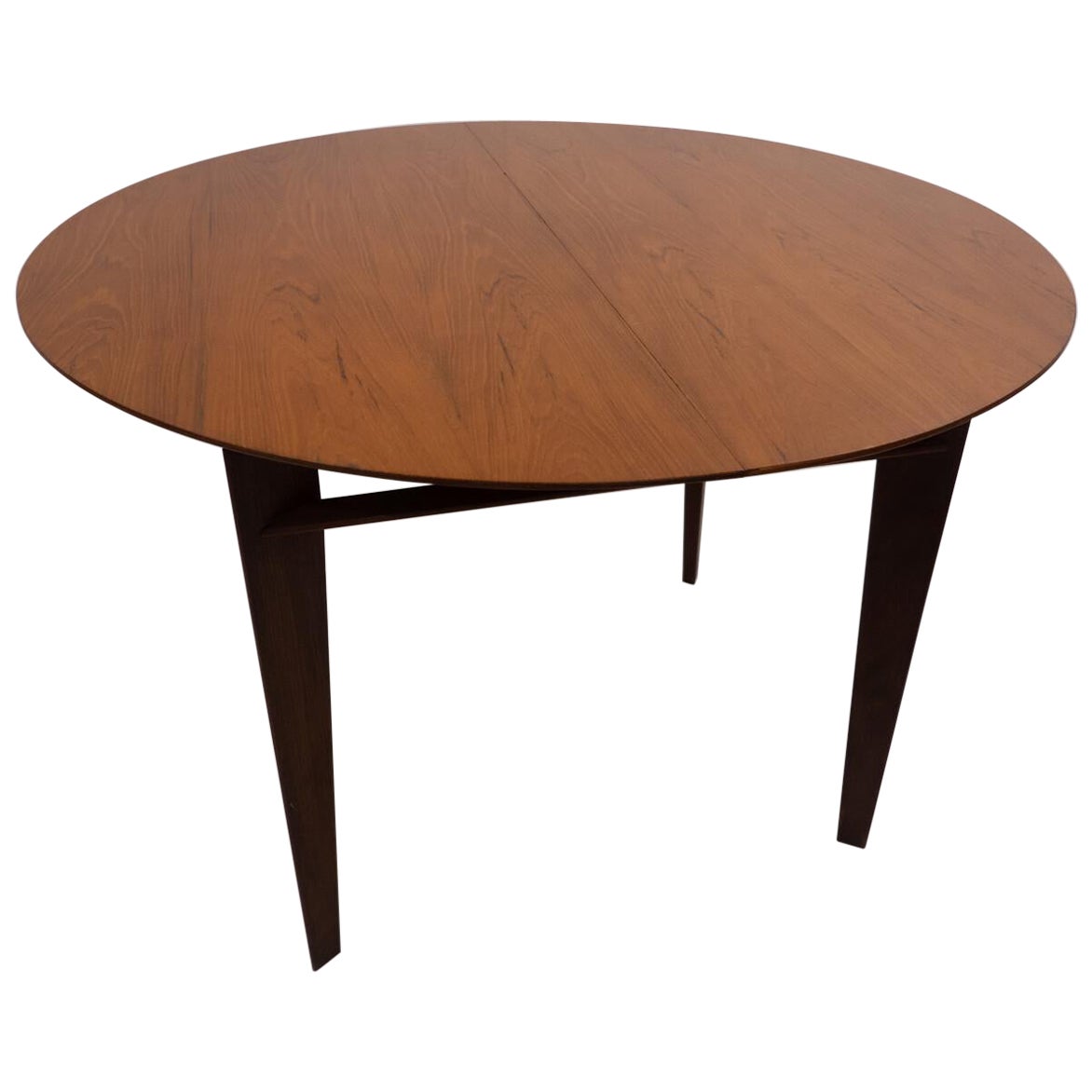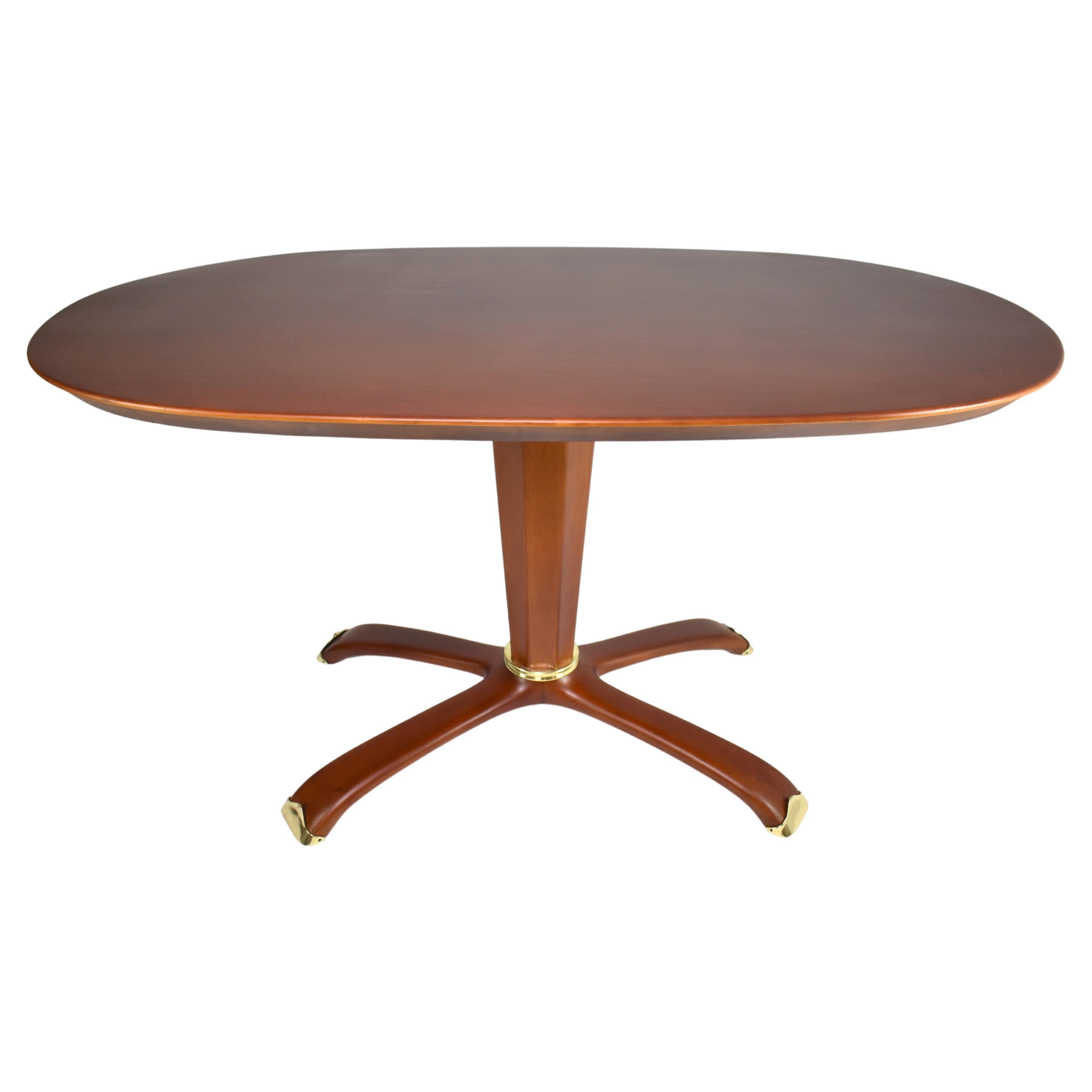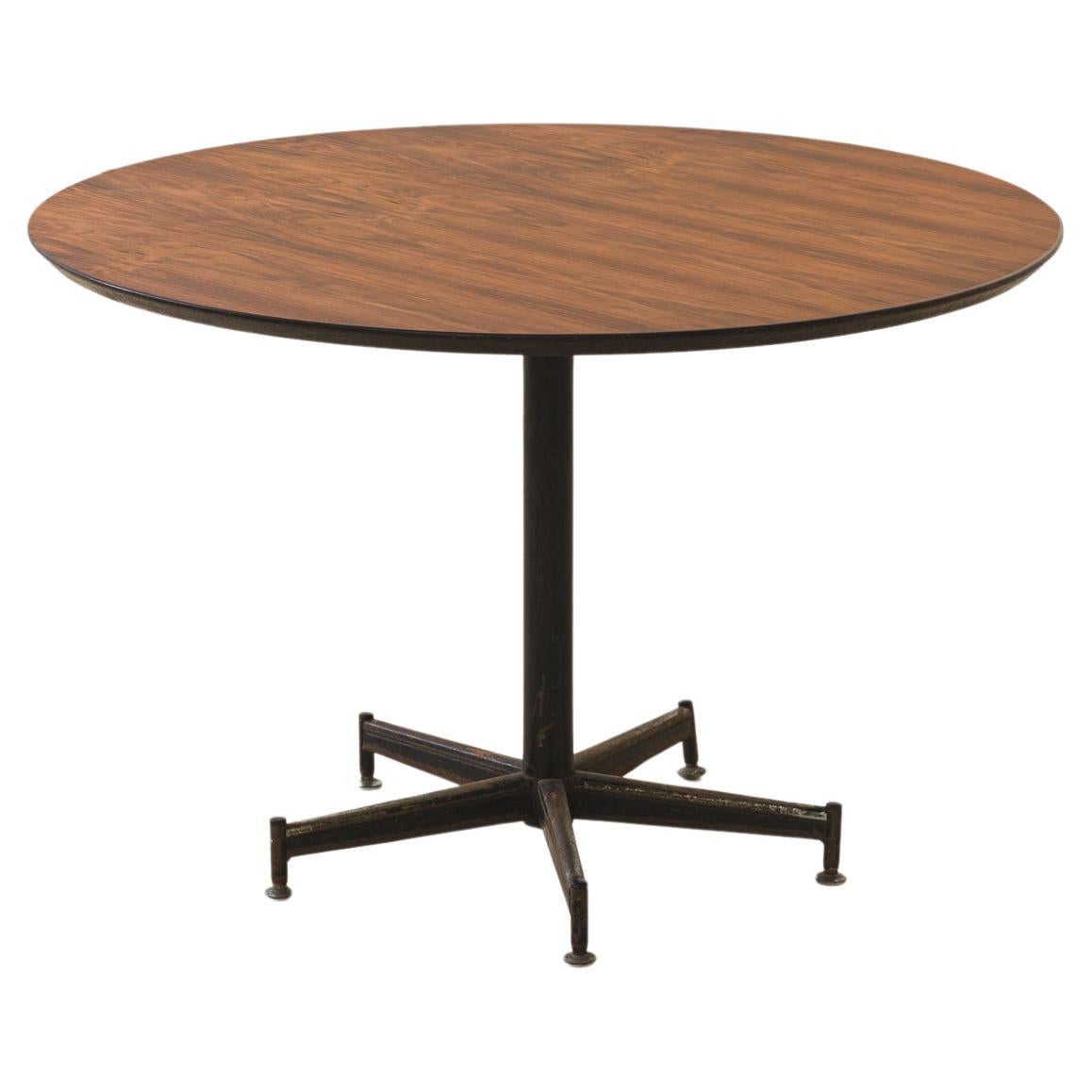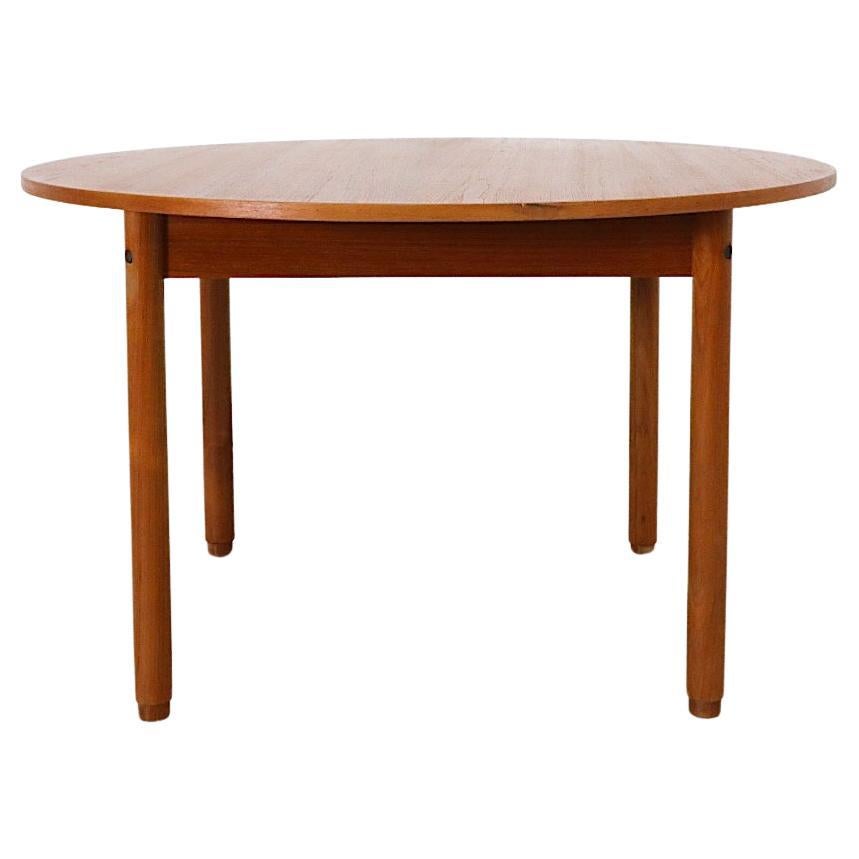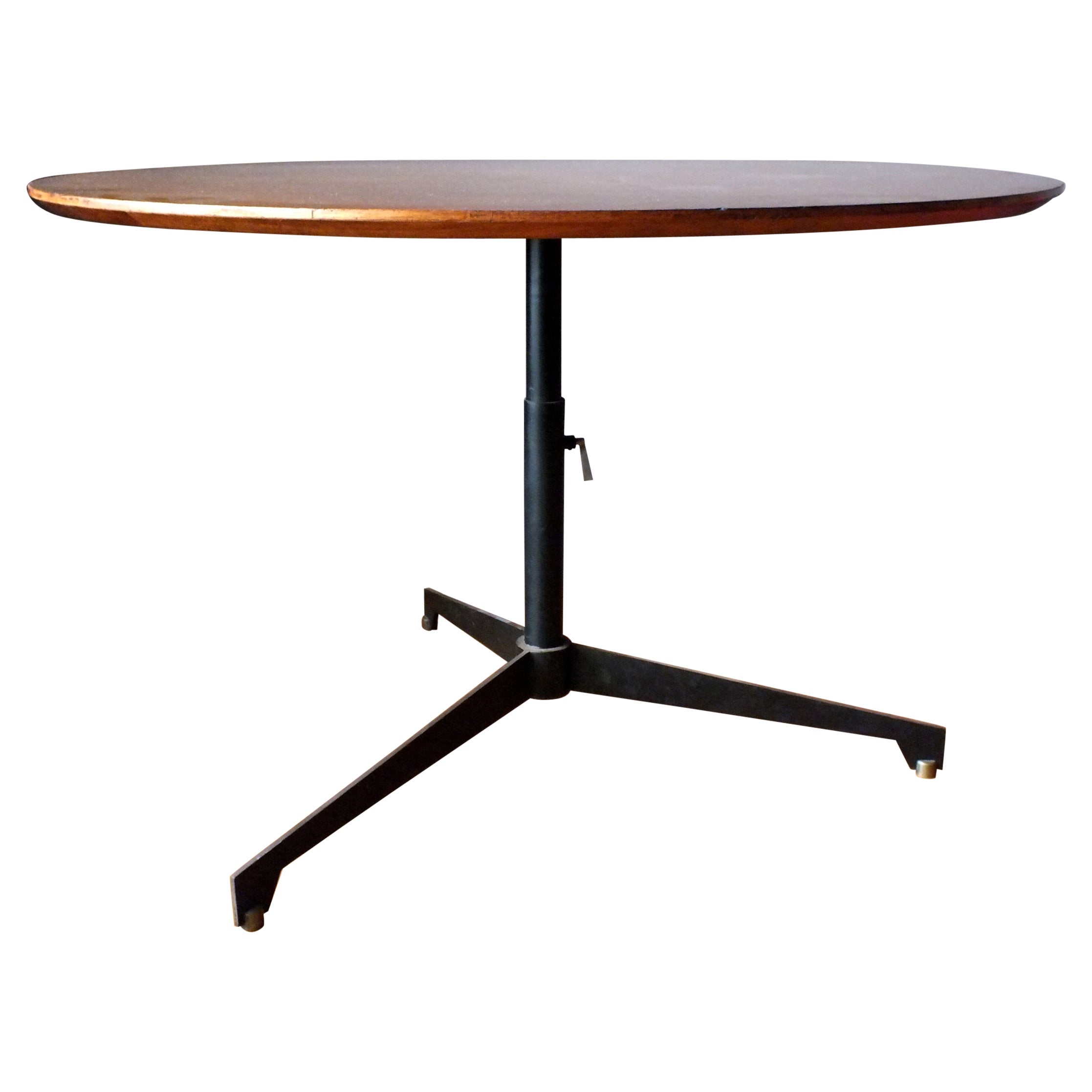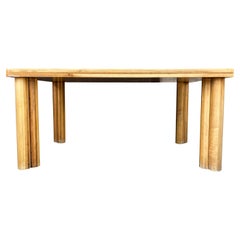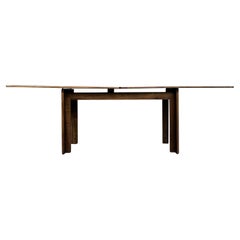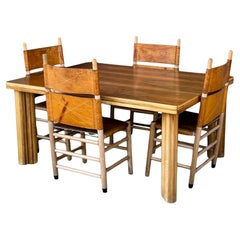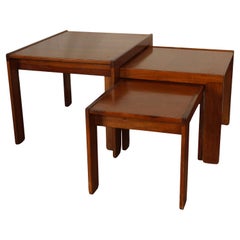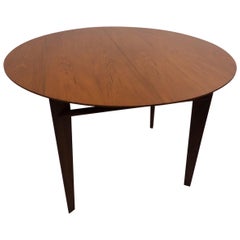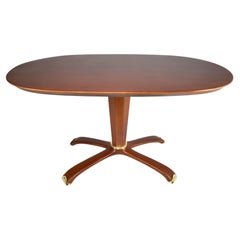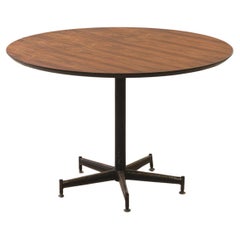Items Similar to Vittorio Nobili Mid-Century Teak Medea Table, 1956
Want more images or videos?
Request additional images or videos from the seller
1 of 13
Vittorio Nobili Mid-Century Teak Medea Table, 1956
$5,947.93
£4,406.37
€5,000
CA$8,181.03
A$9,099.66
CHF 4,773.67
MX$111,036.48
NOK 59,915.55
SEK 56,463.14
DKK 38,069.34
About the Item
Medea dining circular table, designed by Vittorio Nobili for Fratelli Tagliabue in 1954.
Made of teak iron and brass, excellent vintage condition.
Reported at “Compasso d’Oro Prize at Milano Triennale, in 1956.
The Medea table was manufactured in Italy between 1950 to 1959. The manufacturer of this chair was Fratelli Tagliabue. Vittorio Nobili designed it. Although he designed this chair in vintage times, it is suitable for our modern needs.
This table adds elegance and looks to its surroundings. This table was reported at the prestigious Industrial Design Award, Compasso d’Oro, in 1955. Other iconic pieces, such as Soriana by Afra and Tobia Scarpa and Le Bambole by Mario Bellini, will win this prize in the following editions. The creator, Vittorio Nobili, was a known designer, and he has designed many contemporary pieces that fit perfectly in the modern world.
- Creator:Fratelli Tagliabue (Manufacturer),Vittorio Nobili (Designer)
- Dimensions:Height: 31.11 in (79 cm)Diameter: 42.92 in (109 cm)
- Style:Mid-Century Modern (Of the Period)
- Materials and Techniques:
- Place of Origin:
- Period:
- Date of Manufacture:1956
- Condition:Minor fading.
- Seller Location:Vicenza, IT
- Reference Number:1stDibs: LU8019241863202
About the Seller
4.8
Platinum Seller
Premium sellers with a 4.7+ rating and 24-hour response times
Established in 2018
1stDibs seller since 2023
38 sales on 1stDibs
Typical response time: 6 hours
- ShippingRetrieving quote...Shipping from: Vicenza, Italy
- Return Policy
Authenticity Guarantee
In the unlikely event there’s an issue with an item’s authenticity, contact us within 1 year for a full refund. DetailsMoney-Back Guarantee
If your item is not as described, is damaged in transit, or does not arrive, contact us within 7 days for a full refund. Details24-Hour Cancellation
You have a 24-hour grace period in which to reconsider your purchase, with no questions asked.Vetted Professional Sellers
Our world-class sellers must adhere to strict standards for service and quality, maintaining the integrity of our listings.Price-Match Guarantee
If you find that a seller listed the same item for a lower price elsewhere, we’ll match it.Trusted Global Delivery
Our best-in-class carrier network provides specialized shipping options worldwide, including custom delivery.More From This Seller
View AllCarlo Scarpa Mid-Century Brown Walnut “Scuderia” Dining Table for Bernini, 1977
By Bernini, Carlo Scarpa
Located in Vicenza, IT
“Scuderia” dining table, designed by Carlo Scarpa and produced by the Italian manufacturer Bernini in 1977.
Originally, Carlo Scarpa designed the table to restore the stable of Villa Valmarana in Vicenza in 1972.
The table features a solid walnut structure.
Available also five “Kentucky” dining...
Category
Vintage 1970s Italian Mid-Century Modern Dining Room Tables
Materials
Walnut
Afra & Tobia Scarpa Midcentury “778” Extensible Dining Table for Cassina, 1967
By Cassina, Afra & Tobia Scarpa
Located in Vicenza, IT
The “778” model is an example of solid wood boards arranged to form a C-shaped frame. The table, with a top that opens, is supported by four trestles, two of which are a few centimet...
Category
Vintage 1960s Italian Mid-Century Modern Dining Room Tables
Materials
Walnut
Carlo Scarpa Walnut and Leather "Scuderia" Dining Room Set for Bernini, 1977
By Bernini, Carlo Scarpa
Located in Vicenza, IT
Scuderia dining room set, designed by Carlo Scarpa for the Italian manufacturer Bernini in 1977.
Composed of 5 mod. 783 “Kentucky” dining chairs...
Category
Vintage 1970s Italian Mid-Century Modern Dining Room Tables
Materials
Leather, Plastic, Walnut
Afra & Tobia Scarpa Model 777 Walnut Nesting Coffee Tables for Cassina, 1965
By Cassina, Afra & Tobia Scarpa
Located in Vicenza, IT
Model 777 extractable coffee tables, designed by Afra and Tobia Scarpa for Cassina in 1965.
Made of walnut.
Excellent vintage condition.
They are three coffee tables of different si...
Category
Vintage 1960s Italian Mid-Century Modern Coffee and Cocktail Tables
Materials
Walnut
Studio Simon Granite Brutalist Samo Table in the Style of Carlo Scarpa, 1970
By Carlo Scarpa, Studio Simon
Located in Vicenza, IT
Dining table mod. ‘Samo’ by Studio Simon. Series ‘Ultrarazionale’. Italy, 1970.
Made of granite.
Literature: Giuliana Gramigna, Repertorio 1950-2000, Allemandi, Torino, 2003, p.180.
Excellent vintage condition.
The Samo table was designed in 1970 by the project office of Studio Simon. Carlo Scarpa was the brand's artistic director, and the Venetian architect's style inspired the shapes of this table.
Born in Venice on June 2nd, 1906, Carlo Scarpa began working at a very early age. Only a year after he had first qualified as an architect in 1926, he began working for the Murano glassmakers Cappellin & Co. in a consultative capacity; from 1927, he began to experiment with the Murano glass, and this research not only gave him excellent results here but would also inform his progress for many years to come. Between 1935 and 1937, as he entered his thirties, Carlo Scarpa accepted his first important commission, the renovation of Venice’s Cà Foscari. He adapted the spaces of this stately University building which stands on the banks of the Grand Canal, creating rooms for the Dean’s offices and a new hall for academic ceremonies; Mario Sironi and Mario De Luigi were charged with doing the restoration work on the frescos. After 1945, Carlo Scarpa found himself constantly busy with new commissions, including various furnishings and designs for the renovation of Venice’s Hotel Bauer and designing a tall building in Padua and a residential area in Feltre, which are all worth mention. One of his key works, despite its relatively modest diminished proportions, was the first of many works which were to follow in the nineteen fifties: the [bookshop known as the] Padiglione del Libro, which stands in Venice’s Giardini di Castello and shows clearly Scarpa’s passion for the works of Frank Lloyd Wright. In the years which were to follow, after he had met the American architect, Scarpa repeated similar experiments on other occasions, as can be seen, in particular, in the sketches he drew up in 1953 for villa Zoppas in Conegliano, which show some of his most promising work. However, this work unfortunately never came to fruition. Carlo Scarpa later created three museum layouts to prove pivotal in terms of how 20th century museums were to be set up from then on. Between 1955 and 1957, he completed extension work on Treviso’s Gipsoteca Canoviana [the museum that houses Canova’s sculptures] in Possagno, taking a similar experimental approach to the one he used for the Venezuelan Pavilion at [Venice’s] Giardini di Castello which he was building at the same time (1954-56). In Possagno Carlo Scarpa was to create one of his greatest ever works, which inevitably bears comparison with two other museum layouts that he was working on over the same period, those of the Galleria Nazionale di Sicilia, housed in the Palazzo Abatellis in Palermo (1953-55) and at the Castelvecchio in Verona (1957- 1974), all of which were highly acclaimed, adding to his growing fame. Two other buildings, which are beautifully arranged in spatial terms, can be added to this long list of key works that were started and, in some cases, even completed during the nineteen fifties. After winning the Olivetti award for architecture in 1956, Scarpa began work in Venice’s Piazza San Marco on an area destined to house products made by the Industrial manufacturers Ivrea. Over the same period (1959-1963), he also worked on renovation and restoration of the gardens and ground floor of the Fondazione Querini Stampalia in Venice, which many consider being one of his greatest works. While he busied himself working on-site at the Fondazione Querini Stampalia, Carlo Scarpa also began work building a villa in Udine for the Veritti family. To shed some light on the extent to which his work evolved over the years, it may perhaps be useful to compare this work with that of his very last building, villa Ottolenghi Bardolino, which was near to completion at the time of his sudden death in 1978. Upon completion of villa Veritti over the next ten years, without ever letting up on his work on renovation and layouts, Scarpa accepted some highly challenging commissions which were to make the most of his formal skills, working on the Carlo Felice Theatre in Genoa as well as another theatre in Vicenza.
Towards the end of this decade, in 1969, Rina Brion commissioned Carlo Scarpa to build the Brion Mausoleum in San Vito d’Altivole (Treviso), a piece he continued to work on right up until the moment of his death. Nevertheless, even though he was totally absorbed by work on this mausoleum, there are plenty of other episodes which can offer some insight into the final years of his career. As work on the San Vito d’Altivole Mausoleum began to lessen from 1973, Carlo Scarpa began work building the new headquarters for the Banca Popolare di Verona. He drew up plans that were surprisingly different from the work he was carrying out at the same time on the villa Ottolenghi. However, the plans Carlo Scarpa drew up, at different times, for a monument in Brescia’s Piazza della Loggia commemorating victims of the terrorist attack on May 28th, 1974, make a sharp contrast to the work he carried out in Verona, almost as if there is a certain hesitation after so many mannered excesses. The same Pietas that informs his designs for the Piazza Della Loggia can also be seen in the presence of the water that flows through the Brion Mausoleum, almost as if to give a concrete manifestation of pity in this 20th century work of art. Carlo Scarpa has put together a highly sophisticated collection of structures, occupying the mausoleum’s L-shaped space stretching across both sides of the old San Vito d’Altivole cemetery. A myriad of different forms and an equally large number of different pieces, all of which are separate and yet inextricably linked to form a chain that seems to offer no promise of continuity, rising up out of these are those whose only justification for being there is to bear the warning “si vis vitam, para mortem”, [if you wish to experience life prepare for death] as if to tell a tale that suggests the circle of time, joining together the commemoration of the dead with a celebration of life. At the entrance of the Brion Mausoleum stand the “propylaea” followed by a cloister which ends by a small chapel, with an arcosolium bearing the family sarcophagi, the main pavilion, held in place on broken cast iron supports, stands over a mirror-shaped stretch of water and occupies one end of the family’s burial space. The musical sound of the walkways teamed with the luminosity of these harmoniously blended spaces shows how, in keeping with his strong sense of vision, Carlo Scarpa could make the most of all of his many skills to come up with this truly magnificent space. As well as a great commitment to architectural work, with the many projects which we have already seen punctuating his career, Carlo Scarpa also made many equally important forays into the world of applied arts. Between 1926 and 1931, he worked for the Murano glassmakers Cappellin, later taking what he had learned with him when he went to work for the glassmakers Venini from 1933 until the 1950s. The story of how he came to work on furniture design is different, however, and began with the furniture he designed to replace lost furnishings during his renovation of Cà Foscari. The later mass-produced furniture started differently, given that many pieces were originally one-off designs “made to measure”. Industrial manufacturing using these designs as prototypes came into being thanks to the continuity afforded him by Dino Gavina, who, as well as this, also invited Carlo Scarpa to become president of the company Gavina SpA, later to become SIMON, a company Gavina founded 8 years on, in partnership with Maria Simoncini (whose own name accounts for the choice of company name). Carlo Scarpa and Gavina forged a strong bond in 1968 as they began to put various models of his into production for Simon, such as the “Doge” table, which also formed the basis for the “Sarpi” and “Florian” tables. In the early seventies, other tables that followed included “Valmarana”, “Quatour” and “Orseolo”. While in 1974, they added couch and armchair “Cornaro” to the collection and the “Toledo” bed...
Category
Vintage 1970s Italian Mid-Century Modern Dining Room Tables
Materials
Granite
Italian Design Coffee Table in The Style of Alanda by Paolo Piva, 1980s
By B&B Italia, Paolo Piva
Located in Vicenza, IT
Coffee table in the style of Alanda by Paolo Piva for B&B Italia.
Step into the world of timeless elegance with the Alanda Coffee Table, a celebrated artifact that heralded the 80s ...
Category
Vintage 1980s Italian Industrial Coffee and Cocktail Tables
Materials
Steel
You May Also Like
Mid-Century Modern Extending Dining Table by Vittorio Dassi, Teak, Italy, 1950s
By Dassi
Located in Brussels, BE
Mid-Century Modern extending dining table by Vittorio Dassi, Teak, Italy, 1950s
Measures: H: 77,5 cm W: 113,5 - 162 cm.
Category
Vintage 1950s Italian Mid-Century Modern Dining Room Tables
Materials
Wood
Edmondo Palutari for Dassi Mid-Century Italian Teak Round Dining Table, 1950s
By Edmondo Palutari, Vittorio Dassi
Located in Puglia, Puglia
This table was designed by the famous Italian designer Edmondo Palutari for Vittorio Dassi, using teak wood, in Italy in the 1950s.
The table can be op...
Category
Vintage 1950s Italian Mid-Century Modern Dining Room Tables
Materials
Teak
$3,616 Sale Price
20% Off
1950's Italian Wooden Table by Osvaldo Borsani
By Osvaldo Borsani
Located in Paris, FR
An exquisite Italian oval table designed by Osvaldo Borsani, a pivotal figure in mid-century Italian design, crafted in the 1950s from rich cherry wood. Renowned for his innovative a...
Category
Vintage 1950s Italian Mid-Century Modern Tables
Materials
Wood, Cherry
Brazilian Midcentury Dining Table in Rosewood, Unknown Designer, 1960s
Located in New York, NY
Hidden among Brazil's modern furniture heritage are pieces whose origins remain a mystery. These designs, beautifully crafted and steeped in the aesthetics of their time, are yet to ...
Category
Vintage 1960s Brazilian Mid-Century Modern Dining Room Tables
Materials
Metal
Mid-Century Round Teak dining table by Saporiti, Italy
By Saporiti
Located in Los Angeles, CA
Mid-Century round teak Italian dining table by Saporiti. Beautiful teak grain with round legs understated steel accents and manufacturer sticker. In original condition with light wea...
Category
Mid-20th Century Italian Mid-Century Modern Dining Room Tables
Materials
Steel
1950s Osvaldo Borsani for Tecno Italy Table Walnut
By Osvaldo Borsani
Located in Biella, IT
Osvaldo Borsani for Tecno Italy table walnut, iron, particular brass years '54.
Adjustable in height, measure diameter 48 inches, and are for 4/6 perso...
Category
Vintage 1950s Italian Mid-Century Modern Tables
Materials
Metal, Brass
More Ways To Browse
Ello Travertine Table
English Crank Dining Table
Extendable Dining Table Gothic
Extension Octagon Table
French Laminate Cafe Tables
Giovanni Ferrabini
Glostrup Teak Dining Table
Gustavian Extension Table
Henredon Glass Top Dining Table
Herman Miller Oval Conference Table
Hunting Table Mogensen
Ibex Ram Head Dining Table
Jl Moller Table
Mahogany Crank Dining Table
Mastercraft Rhone
Mid Century Surfboard Dining Table Walnut
Moon Dining Table Gubi
Narrow Harvest Tables
